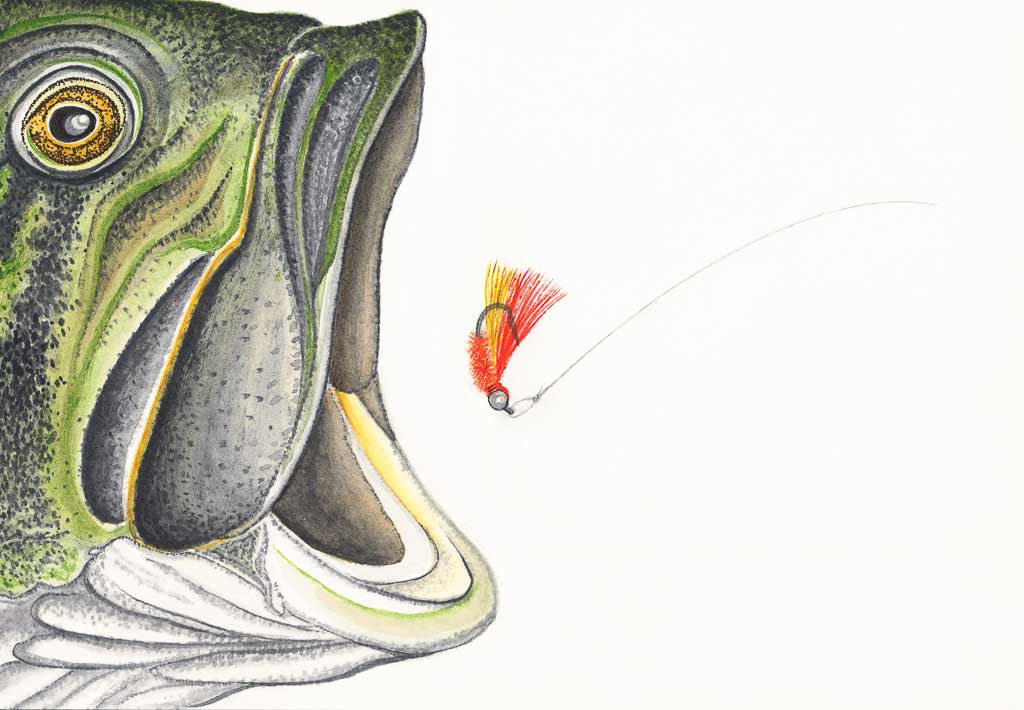Smaller and Quieter Can Be Better, Part III: Largemouth Bass

illustration by Carol Ann Morris
Size 12 at least leans towards large for a trout fly, but compared with a palm-filling hair bug for largemouth or smallmouth bass, it’s a runt. Just as a whopping pound-and-a-half bluegill’s a runt alongside an average steelhead of, say, eight pounds.
Fly size, like fish size, is always relative. On average, highly relative.
Nonetheless, on largemouth-dinky size 12 wet flies I’ve occasionally caught ultra-cautious largemouth bass that wouldn’t budge for a fly any larger. Little nymphs—considerably smaller than size 12—have fooled clear-water smallmouth bass for me when the usual, much bigger streamers and hair bugs failed. Yes, small flies can be right for bass. And when they are, it’s probably because the bass are pestered routinely by anglers into developing discriminating tastes. But even though they may share a weakness, occasionally, for small flies, smallmouth and largemouth bass are very different fishes. Each deserves its own treatment on almost any topic. So, from here on, I choose… largemouths.
A gravel-pit pond only a few minutes’ drive from my dorm helped drive down my GPA back during my college years. On late-spring afternoons into evenings the pond was sparsely rimmed with anglers of all sorts. But during midday, when kids were in school and their parents at work, I was sometimes there alone, missing classes, fishing hard. A few of the bass in the pond had survived the daily angling onslaught and grown large. I tried everything in order to catch them. On occasion I did catch one of those hefty largemouths, but that was so rare that I concentrated mostly on the plentiful bluegills.
Then one day—probably the only time I took my tiny rowboat out on that little pond—I was working the shoreline with a size 12 Carrot Nymph, an old Pacific Northwest wet-fly pattern of mostly orange dubbing and pliant spidery hackles. I expected bluegills, as usual, on such a small fly.
I dropped the fly next to the outer edge of a weed bed, let it sink a bit, and gave it a tug. A few more tugs and a bass of probably over three pounds grabbed it, lit up at the hook sting, and started towing me and my dinky boat around. I got him to where could see his heavy jaws and big, scowling head and the impressive length and girth of him as he struggled just a foot down. Then, breaking my heart, he came off as suddenly as he’d yanked on my little fly to begin with.
The whole thing left me stunned. I’d rarely gotten more than suspicious looks from the bass in that pond when fishing real bass-size flies. Yet this fish seemed to snap up my insignificant little wet fly with confidence. Further investigation was clearly warranted; I’d have to sacrifice more class time for this important study. Eventually my experimentation convinced me that my wet fly must have looked too easy to resist—and too small to arouse that jaded old bass’s suspicions.
I eventually hooked quite a few heavy bass in that and some other nearby gravel-pit ponds using small flies—tiny flies by largemouth standards.
Tossing little flies at largemouths has become nothing close to a habit for me—I always start out with the usual beefy hair bugs or long streamers. But every angler who’s logged considerable time throwing poppers and foam bugs and nymphs tied on small hooks to catch bluegills and crappie and other panfishes has hooked largemouth bass heavy enough to make them wonder Why the devil did this beast bother with that little morsel? It happens, and it’s usually an accident when it does happen. I’m just saying, if the usual chunky largemouth flies aren’t working—and especially if the bass are wised up by angler harassment (as in a small gravel-pit pond near a college town, for example) try smaller flies than you’d normally consider showing largemouth bass. Could be just the thing.











